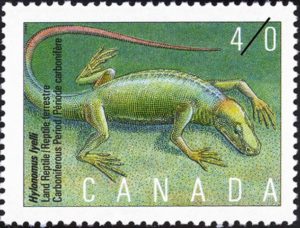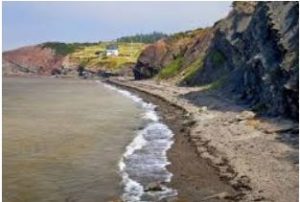Captivating Carboniferous History of Nova Scotia
Imagine Nova Scotia as a tropical land, lush with greenery, animals and bug life. Hundreds of millions of years later, fossils tell the captivating story.
Lush green ferns rustled as 6-foot-long centipedes scuttled across soft peat and leaves for cover. The cool rain fell, but it provided only a temporary respite from the steamy year-round heat. Overhead, dragonflies with wingspans of nearly 2-1/2 feet fluttered, settled on the huge, high treetops and took flight again. The plants, amphibians, reptiles and insects were thriving in the tropical rainforest of Nova Scotia. Nova Scotia?
Fossils in the Carboniferous Period
Located near the equator over 350 million years ago, Nova Scotia was part of Pangaea, “wedged between the ancient North American and African continents,” according to Nova Scotia Museum. As the oversized plants and animals cycled through life and death, they fell, decaying in the marshy and boggy ground. After hundreds of millions of years and resettling of the earth’s surface, the sediment transformed into a thick layer of coal, with fossils buried deep, waiting to tell the stories of their time. Set in the late Paleozoic era, the time of coal development was named the Carboniferous Period.
Dawson Found World’s Oldest Reptile Skeleton
Fascinated with geology even as a young boy, William Dawson of Pictou, Nova Scotia took a year of geology studies in 1840 at the University of Edinburgh when he was twenty years old. Returning home, he was employed in the mining industry and published articles on geologic field work. With Dawson as guide for renowned geologist Charles Lyell, the two men visited Joggins, a coal-deposit site on the Atlantic coast. The area been surveyed only a few years earlier by William Logan of the Geological Survey of Canada. (Mount Logan in British

Joggins Fossil Cliff’s “Hylonomus Lyelli,” named for geologist Charles Lyell, found 1859 with William Dawson. Canada Post, April 1991
Columbia is named after the prestigious geologist.) On further trips in 1851 and 1859, Dawson and Lyell found the fossils of ancient tree trunks and reptiles buried in the rock cliffs. One small fossil found trapped in a tree trunk, named by Dawson the Hylonomus Lyelli after his colleague, was determined then to be the oldest reptile skeleton ever found. The site became known as the Joggins Fossil Cliffs.
Longest-serving Principal of McGill University
Joining McGill University in Montreal, Quebec in 1854, Dawson was Principal, teaching the sciences of paleontology and geology. During his tenure, he turned the agricultural area school into an influential, respected institution. With honour of being McGill’s longest-serving Principal, Dawson retired from the job in 1893 at age 73 – after almost 4 decades of service. He received Knighthood from Queen Victoria in 1884. Occasionally, Dawson was criticized for his theories and discoveries that often disagreed with those of another prominent scientist of Dawson’s era, Charles Darwin.
Though recognized internationally as a top geologist, Dawson was not often celebrated for his geological successes. “Dawson was a man so far ahead of his time that much of the research he did was not appreciated in his lifetime,” said Robert Carroll, McGill University Paleontologist in the 2008 Montreal Gazette article, “Rocking the Science World” by Marian Scott.
Joggins Fossil Cliffs are World Natural Heritage Site
The Joggins Fossil Cliffs were named a UNESCO World Natural Heritage site in 2008, recognizing the area as “the world’s richest, most representative and most significant Coal Age Fossil site,” said Joggins Fossil Cliffs announcement. The fossil site joined the Galapagos Islands and the Great Barrier Reefs, among others, in having the international heritage honour. The Joggins Fossil Cliffs had found a taste of fame much earlier also, being mentioned by Charles Darwin in his famous writings on evolution in the mid-1800s.
Fossils of the Carboniferous Period
Fossils of the flourishing tropical life from the Carboniferous Period continue to surface in Nova Scotia under the skilled hands of geologists yet today. There are a number of other sites dating to the coal age on the globe but, “many geologists,” says the Canadian Encyclopedia, “believe that the cliffs preserve the most complete record of life in the Pennsylvanian [late] Period (341 to 289 million years ago) anywhere in the world.” After many other findings of fossils and skeletal remains, Dawson’s Hylonomus Lyelli still holds the title of the world’s oldest reptile fossil.
This article first appeared on Suite101 in 2009. Copyright Susanna McLeod

